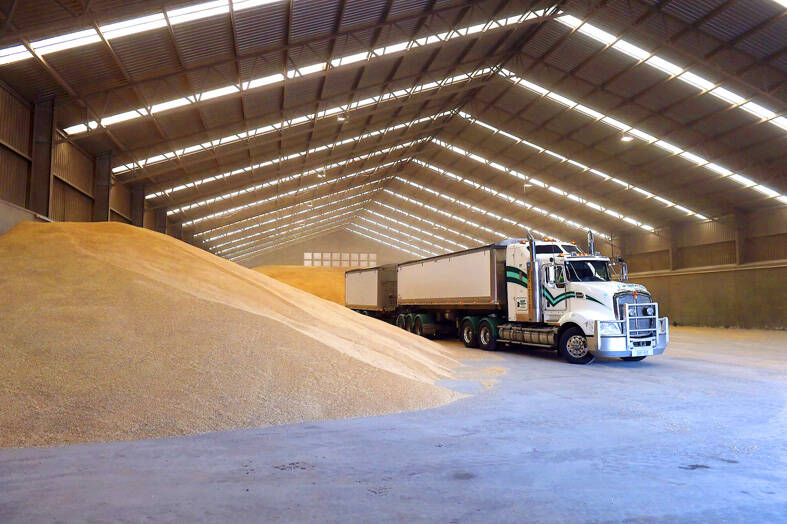Three years after steep Chinese tariffs halted imports of Australian barley as tensions between the two countries ratcheted higher, the grain once again is flowing freely.
Barley is not only used to brew beer, but to feed pigs, and China was Australia’s leading market, taking 50 percent of its barley exports. China has imported 314,000 tonnes of Australian barley worth A$139 million (US$94.7 million) since the government scrapped its 80.5 percent tariffs in August, the Australian government said early this month, citing official Chinese data.
The resumption of trade is a welcome relief for Australian farmers, who saw a nearly A$1 billion market evaporate in 2020.

Photo: Bloomberg
“In the two months following the market’s reopening, [CBH] Marketing and Trading shipped two vessels of barley to China,” the CBH Group, a cooperative of more than 3,500 Western Australian grain farmers, said in its annual report.
Tensions between the countries began to mount in 2018 when Australia excluded Chinese telecommunications giant Huawei Technologies Co (華為) from its 5G network. Then in 2020, Australia called for an international investigation into the origins of COVID-19 — an action China saw as politically motivated as it came from a close partner of the US.
In response, Beijing slapped high tariffs on key Australian exports, including barley, beef and wine, while halting its coal imports.
A slowdown in China’s economic growth has spurred Beijing to rekindle its relationships with its trading partners.
Meanwhile, Australia sought out and found new markets to offload its harvests — it is the world’s third-largest producer of the grassy grain.
“It caused us to pivot, so we found new markets, like Mexico. We managed to have tariffs lowered, which were previously in excess of 100 percent,” said Sean Cole, acting general manager of the GrainGrowers trade association.
“With China gone, Australia was really forced to go back to more traditional customers in the feed market, mainly the Middle East and Saudi Arabia, where we’ve been for over 20 years,” he said. Between June last year and June this year, Saudi Arabia became the leading importer of Australian barley, data from the Australian Bureau of Agricultural and Resource Economics and Sciences (ABARES) showed.
Lyndon Mickel farms a 6,000 hectare plot near Beaumont in the southwest part of Australia. His most recent harvest fields of grains and peas was the 23rd of his career, but it has taken time to bounce back from the Chinese tariffs.
“We’ve had a reduction in price, but we’ve been fortunate we’ve had two very good years in that time crop-wise, so what we’ve lost in price, we’ve gained in tonnage anyway,” he said.
However, those boom years — producing more than 14 million tonnes of barley in the past two harvests — are over.
As El Nino — the cyclical weather phenomenon responsible for higher global temperatures — returns to the Pacific, ABARES expects barley production to drop 24 percent to 10.8 million tonnes for the 2023-2024 harvest.
The reopening of the Chinese market could not have come at a better time, Cole said.
“A lot of our barley is classified as feed, but it is still suitable for beer manufacturing in China,” he said. “They use slightly different processes, and essentially it means we can get a premium for more of our feed barley.”
On average, barley destined for China is sold for “around 38 to 40 dollars a tonne between now and since the tariffs were lifted” and that amounts to “an extra 400 million dollars value for the Australia barley crop next year, even with a smaller crop,” Cole added.

CHIP RACE: Three years of overbroad export controls drove foreign competitors to pursue their own AI chips, and ‘cost US taxpayers billions of dollars,’ Nvidia said China has figured out the US strategy for allowing it to buy Nvidia Corp’s H200s and is rejecting the artificial intelligence (AI) chip in favor of domestically developed semiconductors, White House AI adviser David Sacks said, citing news reports. US President Donald Trump on Monday said that he would allow shipments of Nvidia’s H200 chips to China, part of an administration effort backed by Sacks to challenge Chinese tech champions such as Huawei Technologies Co (華為) by bringing US competition to their home market. On Friday, Sacks signaled that he was uncertain about whether that approach would work. “They’re rejecting our chips,” Sacks

NATIONAL SECURITY: Intel’s testing of ACM tools despite US government control ‘highlights egregious gaps in US technology protection policies,’ a former official said Chipmaker Intel Corp has tested chipmaking tools this year from a toolmaker with deep roots in China and two overseas units that were targeted by US sanctions, according to two sources with direct knowledge of the matter. Intel, which fended off calls for its CEO’s resignation from US President Donald Trump in August over his alleged ties to China, got the tools from ACM Research Inc, a Fremont, California-based producer of chipmaking equipment. Two of ACM’s units, based in Shanghai and South Korea, were among a number of firms barred last year from receiving US technology over claims they have

It is challenging to build infrastructure in much of Europe. Constrained budgets and polarized politics tend to undermine long-term projects, forcing officials to react to emergencies rather than plan for the future. Not in Austria. Today, the country is to officially open its Koralmbahn tunnel, the 5.9 billion euro (US$6.9 billion) centerpiece of a groundbreaking new railway that will eventually run from Poland’s Baltic coast to the Adriatic Sea, transforming travel within Austria and positioning the Alpine nation at the forefront of logistics in Europe. “It is Austria’s biggest socio-economic experiment in over a century,” said Eric Kirschner, an economist at Graz-based Joanneum

BUBBLE? Only a handful of companies are seeing rapid revenue growth and higher valuations, and it is not enough to call the AI trend a transformation, an analyst said Artificial intelligence (AI) is entering a more challenging phase next year as companies move beyond experimentation and begin demanding clear financial returns from a technology that has delivered big gains to only a small group of early adopters, PricewaterhouseCoopers (PwC) Taiwan said yesterday. Most organizations have been able to justify AI investments through cost recovery or modest efficiency gains, but few have achieved meaningful revenue growth or long-term competitive advantage, the consultancy said in its 2026 AI Business Predictions report. This growing performance gap is forcing executives to reconsider how AI is deployed across their organizations, it said. “Many companies